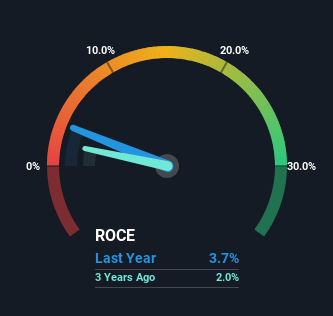- Israel
- /
- Renewable Energy
- /
- TASE:ENLT
Enlight Renewable Energy (TLV:ENLT) Shareholders Will Want The ROCE Trajectory To Continue
If you're not sure where to start when looking for the next multi-bagger, there are a few key trends you should keep an eye out for. Typically, we'll want to notice a trend of growing return on capital employed (ROCE) and alongside that, an expanding base of capital employed. Ultimately, this demonstrates that it's a business that is reinvesting profits at increasing rates of return. Speaking of which, we noticed some great changes in Enlight Renewable Energy's (TLV:ENLT) returns on capital, so let's have a look.
What Is Return On Capital Employed (ROCE)?
Just to clarify if you're unsure, ROCE is a metric for evaluating how much pre-tax income (in percentage terms) a company earns on the capital invested in its business. Analysts use this formula to calculate it for Enlight Renewable Energy:
Return on Capital Employed = Earnings Before Interest and Tax (EBIT) ÷ (Total Assets - Current Liabilities)
0.037 = US$138m ÷ (US$4.2b - US$484m) (Based on the trailing twelve months to September 2023).
Therefore, Enlight Renewable Energy has an ROCE of 3.7%. On its own that's a low return, but compared to the average of 2.4% generated by the Renewable Energy industry, it's much better.
View our latest analysis for Enlight Renewable Energy

In the above chart we have measured Enlight Renewable Energy's prior ROCE against its prior performance, but the future is arguably more important. If you'd like, you can check out the forecasts from the analysts covering Enlight Renewable Energy here for free.
So How Is Enlight Renewable Energy's ROCE Trending?
While in absolute terms it isn't a high ROCE, it's promising to see that it has been moving in the right direction. Over the last five years, returns on capital employed have risen substantially to 3.7%. The company is effectively making more money per dollar of capital used, and it's worth noting that the amount of capital has increased too, by 462%. So we're very much inspired by what we're seeing at Enlight Renewable Energy thanks to its ability to profitably reinvest capital.
What We Can Learn From Enlight Renewable Energy's ROCE
In summary, it's great to see that Enlight Renewable Energy can compound returns by consistently reinvesting capital at increasing rates of return, because these are some of the key ingredients of those highly sought after multi-baggers. Since the stock has returned a staggering 256% to shareholders over the last five years, it looks like investors are recognizing these changes. Therefore, we think it would be worth your time to check if these trends are going to continue.
If you'd like to know more about Enlight Renewable Energy, we've spotted 3 warning signs, and 2 of them are a bit unpleasant.
If you want to search for solid companies with great earnings, check out this free list of companies with good balance sheets and impressive returns on equity.
Valuation is complex, but we're here to simplify it.
Discover if Enlight Renewable Energy might be undervalued or overvalued with our detailed analysis, featuring fair value estimates, potential risks, dividends, insider trades, and its financial condition.
Access Free AnalysisHave feedback on this article? Concerned about the content? Get in touch with us directly. Alternatively, email editorial-team (at) simplywallst.com.
This article by Simply Wall St is general in nature. We provide commentary based on historical data and analyst forecasts only using an unbiased methodology and our articles are not intended to be financial advice. It does not constitute a recommendation to buy or sell any stock, and does not take account of your objectives, or your financial situation. We aim to bring you long-term focused analysis driven by fundamental data. Note that our analysis may not factor in the latest price-sensitive company announcements or qualitative material. Simply Wall St has no position in any stocks mentioned.
About TASE:ENLT
Enlight Renewable Energy
Operates a renewable energy platform in Israel, Central-Eastern Europe, Western Europe, and the United States.
Proven track record with moderate growth potential.
Market Insights
Community Narratives




